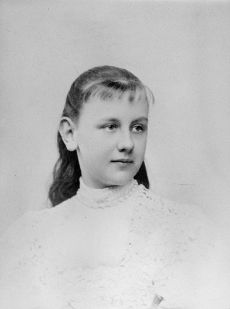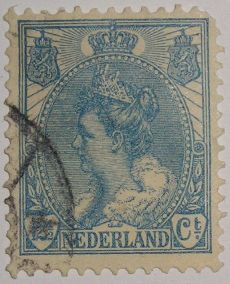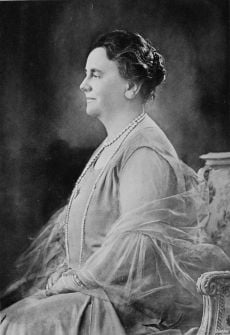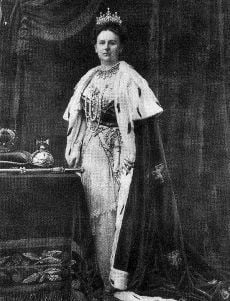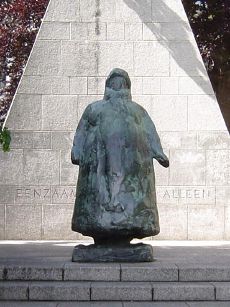Wilhelmina of the Netherlands
- This article is about Wilhelmina of the Netherlands. For other uses of Wilhelmina, see Wilhelmina (disambiguation).
| Wilhelmina | ||
|---|---|---|
| Queen of the Netherlands | ||
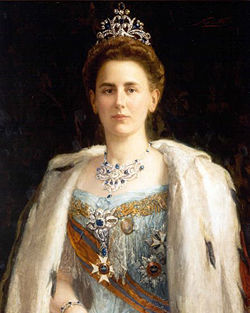
| ||
| Reign | 23 November 1890 – 4 September 1948 (57 years) | |
| Born | August 31 1880 | |
| The Hague, Netherlands | ||
| Died | 28 November 1962 (aged 82) | |
| Het Loo, Apeldoorn, Netherlands | ||
| Buried | Nieuwe Kerk, Delft, Netherlands | |
| Predecessor | William III of the Netherlands | |
| Successor | Juliana of the Netherlands | |
| Consort | Hendrik of Mecklenburg-Schwerin | |
| Issue | Juliana of the Netherlands | |
| Royal House | Orange-Nassau | |
| Royal anthem | Wien Neerlands Bloed (until 1932) Het Wilhelmus (from 1932) | |
| Father | William III of the Netherlands | |
| Mother | Emma of Waldeck and Pyrmont | |
Wilhelmina (Wilhelmina Helena Pauline Marie of Orange-Nassau; 31 August 1880 – 28 November 1962) was queen regnant of the Kingdom of the Netherlands from 1890 to 1948. She ruled the Netherlands for fifty-eight years, longer than any other Dutch monarch. Her reign saw World War I and World War II, the Great Crisis of 1933, and the decline of the Netherlands as a major colonial empire. Outside the Netherlands she is primarily remembered for her role in the Second World War, in which she proved to be a great inspiration to the Dutch resistance, as well as a prominent leader of the Dutch government in exile [1].
Early life
Princess Wilhelmina Helena Pauline Marie of Orange-Nassau was born on 31 August 1880 in The Hague, Netherlands. She was the only child of King William III and his second wife, Emma of Waldeck and Pyrmont. Her childhood was characterised by a close relationship with her parents, especially with her father, who was already 63 years of age when she was born.
King William had three sons with his first wife, Sophie of Württemberg. However when Wilhelmina was born, William had already outlived two of them and only the childless Prince Alexander was alive, so she was second in line to the throne from birth. When Wilhelmina was four, Alexander died and the young girl became heiress presumptive.
King William III died on 23 November 1890, and, although Princess Wilhelmina became Queen of the Netherlands instantly, her mother, Emma, was named Regent. In 1895, Wilhelmina visited the venerable and formidable Queen Victoria, who penned a crisp evaluation in her diary:
The young Queen ... still has her hair hanging loose. She is slender and graceful, and makes an impression as a very intelligent and very cute girl. She speaks good English and knows how to behave with charming manners.[1]
In 1901, she married Hendrik, Duke of Mecklenburg-Schwerin. Although the marriage was said to be essentially without love, initially Wilhelmina truly cared for Hendrik, and it is likely that those feelings were mutual.[citation needed] Hendrik however, suffered from his role as prince-consort, stating that it was boring to be nothing more than decoration, forced always to walk one step behind his wife.[citation needed] He had no power in the Netherlands, and Wilhelmina made sure this remained so.[citation needed]
A series of miscarriages also contributed to a crisis in their marriage. Prince Hendrik is reported to have had several illegitimate children.[citation needed] Over time the marriage became less happy.[citation needed] The birth of Juliana, on 30 April 1909, was met with great relief after eight years of childless marriage. [2]
De facto reign
Queen Wilhelmina | |||||||
|
Tactful, and careful to operate within the limitations of what was expected by the Dutch people and their elected representatives, the strong-willed Wilhelmina became a forceful personality who spoke and acted her mind. These qualities showed up early on in her reign when, at the age of 20, Queen Wilhelmina ordered a Dutch warship to South Africa to rescue Paul Kruger, the embattled President of the Transvaal. For this, Wilhelmina gained international stature and earned the respect and admiration of people all over the world.
Wilhelmina had a stern dislike of the United Kingdom [citation needed], which had annexed the republics of Transvaal and Orange Free State in the Boer War. The Boers were descendants of early Dutch colonists, to whom Wilhelmina felt very closely linked. This stern dislike did not apparently inhibit her from calling on the UK to rescue her from the Nazis in 1940 though, by demanding of King George VI that he send her fighter squadrons to defend the Netherlands and a warship to pick up her, her family and Government. A warship, HMS Hereward, was sent to her rescue and brought her to safety in the UK, which generously offered facilities to her and her Government, including broadcasting time on the BBC to the Netherlands. This may have ameliorated her earlier stern dislke of the UK.
Queen Wilhelmina also had a keen understanding of business matters and her investments made her the world's richest woman, a title retained by her daughter and granddaughter, Beatrix. The Dutch Royal Family is still reputed to be the single largest shareholder of Royal Dutch Shell.
Prior to the outbreak of the First World War, a young Wilhelmina visited the powerful Kaiser Wilhelm II of Germany, who boasted to the Queen of a relatively small country, "my guards are seven feet tall and yours are only shoulder-high to them". Wilhelmina smiled politely and replied, "Quite true, Your Majesty, your guards are seven feet tall. But when we open our dikes, the water is ten feet deep!".[2]
World War I
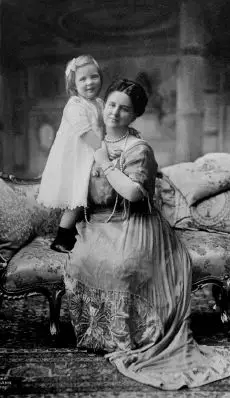
The Netherlands remained neutral during World War I. Germany had sizeable investments in the Dutch economy combined with a large trading partnership in goods. To weaken the German Empire, the United Kingdom blockaded Dutch ports. In response the Dutch government traded with Germany. German soldiers were given Edam cheese for their rations before an assault.
Wilhelmina was a "soldier's queen"; being a woman, she could not be Supreme Commander, but she nevertheless used every opportunity she had to inspect her forces. On many occasions she appeared without prior notice, wishing to see the reality, not a prepared show. She loved her soldiers, but was very unhappy with most of her governments, which used the military as a constant source for budget-cutting. Wilhelmina wanted a small but well trained and equipped army. However, this was far from the reality.
In the war, she felt she was a "Queen-On-Guard". She was always wary of a German attack, especially in the beginning. However, violation of Dutch territorial sovereignty came from both Britain and the United States, who, with the blockade, captured many Dutch trade and cargo ships in an attempt to disrupt the German war effort. This led to increased tensions between the Netherlands and the Allied forces.
Civil unrest, spurred on by the Bolshevik revolt in Imperial Russia in 1917, gripped the Netherlands after the war. A socialist leader named Troelstra tried to overthrow the government and the Queen. Instead of a violent revolution, he wanted to control the Tweede Kamer, the legislative body of Parliament, and hoped to achieve this by means of elections, convinced that the working class would support him. However, the popularity of the young Queen helped restore confidence in the government. Wilhelmina brought about a mass show of support by riding with her daughter through the mobs in an open carriage. It was very clear that the revolution would not succeed.
After the armistice ending World War I, Wilhelm fled to the Netherlands, where he was granted political asylum by the Dutch government, partly owing to the Kaiser's family links with Queen Wilhelmina. In response to Allied efforts to get their hands on the deposed Kaiser, Wilhelmina called the Allied Ambassadors to her presence and lectured them on the rights of asylum.[3]
Between the wars
During the 1920s and 1930s, the Netherlands began to emerge as an industrial power. Engineers reclaimed vast amounts of land that had been under water by building the Zuiderzee Works. The death of Wilhelmina's husband, Prince Hendrik, in 1934 brought an end to a difficult year that also saw the passing of her mother Queen Emma.
The interbellum, and most notably the economic crisis of the '30s, was also the period in which Wilhelmina's personal power reached its zenith; under the successive governments of a staunch monarchist prime minister, Hendrik Colijn (ARP), Wilhelmina was deeply involved in most questions of state.
In 1939, Colijn's fifth and last government was swept away by a vote of no confidence two days after its formation. It is widely accepted that Wilhelmina herself was behind the formation of this last government, which was designed to be an extra-parliamentary or 'royal' cabinet. The Queen was deeply sceptical of the parliamentary system and tried to bypass it covertly more than once.
She also arranged the marriage between her daughter Juliana and Bernhard of Lippe-Biesterfeld, a German prince who had lost most of his possessions after the Great War. Although it was claimed that he was initially a supporter of the Nazi regime, no hard evidence of this has ever been found or publicised. It should be stated, however, that there was never a serious investigation into the matter. Prince Bernhard later became a very popular figure in the Netherlands.
World War II
On 10 May 1940, Nazi Germany invaded the Netherlands, and Queen Wilhelmina and her family were evacuated on HMS Hereward to the United Kingdom three days later. Queen Wilhelmina had wanted to stay in the Netherlands: she had planned to go to the southern province of Zeeland with her troops in order to coordinate further resistance from the town of Breskens and remain there until help arrived, much as King Albert I of Belgium had done during World War I. She went aboard a British cruiser at The Hague, which was to take her there. However, when she was on board the captain stated that he was forbidden to make contact with the Dutch shore, as Zeeland was under heavy attack from the Luftwaffe and it was too dangerous to return. Wilhelmina then took the decision to go to Britain, planning to return as soon as possible. Wilhelmina also spent time in Canada during the war, staying at the Governor General's residence, Rideau Hall. It was said that while she was there she made a great impact on the household, notably for living relatively simply. The Queen insisted on doing her shopping personally, walking the streets of Ottawa unassisted (though simply raising her hand to stop traffic whenever she wished to cross the road), and travelling to the United States on a regular civilian train.[4]
The Dutch armed forces in the Netherlands, apart from those in Zeeland, surrendered on 15 May. In Britain, Queen Wilhelmina took charge of the Dutch government in exile, setting up a chain of command and immediately communicating a message to her people.
Relations between the Dutch government and the Queen were tense, with mutual dislike growing as the war progressed. Wilhelmina went on to be the most prominent figure, owing to her experience and knowledge. She was also very popular and respected among the leaders of the world. The government did not have a parliament to back them and had few employees to assist them. The Dutch prime minister Dirk Jan de Geer, believed the Allies would not win and intended to open negotiations with the Nazis for a separate peace. Therefore Wilhelmina sought to remove Jan de Geer from power. With the aid of a minister, Pieter Gerbrandy, she succeeded.
During the war her photograph was a sign of resistance against the Germans. Like Winston Churchill, Queen Wilhelmina broadcast messages to the Dutch people over Radio Oranje.
The Queen called Adolf Hitler "the arch-enemy of mankind." Her late-night broadcasts were eagerly awaited by her people, who had to hide in order to listen to them illegally. An anecdote published in her New York Times obituary illustrates how she was valued by her subjects during this period:
Although celebration of the Queen’s birthday was forbidden by the Nazis, it was commemorated nevertheless. When churchgoers in the small fishing town of Hizen rose and sang one verse of the Dutch national anthem, Wilhelmus van Nassauwe, on the Queen’s birthday, the town paid a fine of 60,000 guilders.[1]
During the war, the Queen was almost killed by a bomb that took the lives of several of her guards and severely damaged her country home near South Mimms in England. In 1944 Queen Wilhelmina became only the second woman to be inducted into the Order of the Garter. Churchill described her as the only real man among the governments-in-exile in London.
In England, she developed ideas about a new political and social life for the Dutch after the liberation. She wanted a strong cabinet formed by people active in the resistance. She dismissed De Geer during the war and installed a prime minister with the approval of other Dutch politicians. The Queen "hated" politicians, instead stating a love for the people. When the Netherlands was liberated in 1945 she was disappointed to see the same political factions taking power as before the war. Prior to the end of the war, in mid-March 1945, she travelled to the Allied occupied areas of southern Holland visiting the region of Walcheren and the city of Eindhoven where she received a rapturous welcome from the local population.[5]
Following the end of World War II, Queen Wilhelmina made the decision not to return to her palace but move into a mansion in The Hague, where she lived for eight months, and she travelled through the countryside to motivate people, sometimes using a bicycle instead of a car. However, in 1947, while the country was still recovering from World War II, the revolt in the oil-rich Dutch East Indies saw sharp criticism of the Queen by the Dutch economic elite. Her loss of popularity and the forced departure from the East Indies under international pressure led to her abdication soon after.
Later years
On 4 September 1948, after a reign of 58 years and 50 days, Wilhelmina abdicated in favour of her daughter Juliana. She was thenceforward styled "Her Royal Highness Princess Wilhelmina of the Netherlands". After her reign, the influence of the Dutch monarchy began to decline but the country's love for its royal family continued. No longer queen, Wilhelmina retreated to Het Loo Palace, making few public appearances until the country was devastated by the North Sea flood of 1953. Once again she travelled around the country to encourage and motivate the Dutch people.
During her last years she wrote her autobiography entitled Eenzaam, maar niet alleen (Lonely but Not Alone), in which she gave account of the events in her life, and revealed her strong religious feelings and motivations.
Queen Wilhelmina died at the age of 82 on 28 November 1962, and was buried in the Dutch Royal Family crypt in the Nieuwe Kerk in Delft, on 8 December. The funeral was, at her request and contrary to protocol, completely in white to give expression to her belief that earthly death was the beginning of eternal life.[6]
Had Wilhelmina not given the throne to her daughter before her death, she would have reigned for 72 years 5 days, which would have been the second-longest reign in Europe (behind that of Louis XIV of France), seventh-longest in the world, and the longest reign by a female monarch in history.
Ancestry
| Ancestors of Wilhelmina of the Netherlands | |||||||||||||||||||||||||||||||||||||||||||||||||||||||||||||||||||||||||||||||||||||||||||||||||||||||||||||||||||||||||||||||||||||||||||||||||||||||||||||||||||||||||||||||||||||||||||||||||||||||||||||||||||||||||||||||||||||||||||||||||||||||||||||||||||||||||||||||||||||||||||||||||||||||||||||||||||||||||||||||||||||||||||||||||||||||||||||||||||||||||||||||||||||||||||||||||||||||||||||||||||||||||||||||||||||||||||||||||||||||||||||||||||||||||||||||||||||||||||||||||||||||||||||||||||||||||||||||||||||||||||||||||||||||||||||||||
|---|---|---|---|---|---|---|---|---|---|---|---|---|---|---|---|---|---|---|---|---|---|---|---|---|---|---|---|---|---|---|---|---|---|---|---|---|---|---|---|---|---|---|---|---|---|---|---|---|---|---|---|---|---|---|---|---|---|---|---|---|---|---|---|---|---|---|---|---|---|---|---|---|---|---|---|---|---|---|---|---|---|---|---|---|---|---|---|---|---|---|---|---|---|---|---|---|---|---|---|---|---|---|---|---|---|---|---|---|---|---|---|---|---|---|---|---|---|---|---|---|---|---|---|---|---|---|---|---|---|---|---|---|---|---|---|---|---|---|---|---|---|---|---|---|---|---|---|---|---|---|---|---|---|---|---|---|---|---|---|---|---|---|---|---|---|---|---|---|---|---|---|---|---|---|---|---|---|---|---|---|---|---|---|---|---|---|---|---|---|---|---|---|---|---|---|---|---|---|---|---|---|---|---|---|---|---|---|---|---|---|---|---|---|---|---|---|---|---|---|---|---|---|---|---|---|---|---|---|---|---|---|---|---|---|---|---|---|---|---|---|---|---|---|---|---|---|---|---|---|---|---|---|---|---|---|---|---|---|---|---|---|---|---|---|---|---|---|---|---|---|---|---|---|---|---|---|---|---|---|---|---|---|---|---|---|---|---|---|---|---|---|---|---|---|---|---|---|---|---|---|---|---|---|---|---|---|---|---|---|---|---|---|---|---|---|---|---|---|---|---|---|---|---|---|---|---|---|---|---|---|---|---|---|---|---|---|---|---|---|---|---|---|---|---|---|---|---|---|---|---|---|---|---|---|---|---|---|---|---|---|---|---|---|---|---|---|---|---|---|---|---|---|---|---|---|---|---|---|---|---|---|---|---|---|---|---|---|---|---|---|---|---|---|---|---|---|---|---|---|---|---|---|---|---|---|---|---|---|---|---|---|---|---|---|---|---|---|---|---|---|---|---|---|---|---|---|---|---|---|---|---|---|---|---|---|---|---|---|---|---|---|---|---|---|---|---|---|---|---|---|---|---|---|---|---|---|---|---|---|---|---|---|---|---|---|---|---|---|---|---|---|---|---|---|---|---|---|---|---|---|---|---|---|---|---|---|---|---|---|---|---|---|---|---|---|---|---|---|---|---|---|---|---|---|---|---|---|---|---|---|---|---|---|---|---|---|---|---|---|---|---|---|---|---|---|---|---|---|---|---|---|---|---|---|---|---|---|---|---|---|---|---|---|---|---|
| |||||||||||||||||||||||||||||||||||||||||||||||||||||||||||||||||||||||||||||||||||||||||||||||||||||||||||||||||||||||||||||||||||||||||||||||||||||||||||||||||||||||||||||||||||||||||||||||||||||||||||||||||||||||||||||||||||||||||||||||||||||||||||||||||||||||||||||||||||||||||||||||||||||||||||||||||||||||||||||||||||||||||||||||||||||||||||||||||||||||||||||||||||||||||||||||||||||||||||||||||||||||||||||||||||||||||||||||||||||||||||||||||||||||||||||||||||||||||||||||||||||||||||||||||||||||||||||||||||||||||||||||||||||||||||||||||
ReferencesISBN links support NWE through referral fees
- General
- Hubbard, Robert H. (1977). Rideau Hall: An Illustrated History of Government House, Ottawa, from Victorian Times to the Present Day. Montreal: McGill-Queen's University Press. 10-ISBN 0-773-50310-2; 13-ISBN 978-0-773-50310-6
- Wilhelmina. (1959). Eenzaam maar niet alleen. Amsterdam: Ten Have Uitgevers Kok. 10-ISBN 9-025-95146-5; 13-ISBN 978-9-025-95146-7
- Specific
- ↑ 1.0 1.1 "Wilhelmina of Netherlands Dies" (UPI), New York Times, 28 November 1962. pp. A1–A39. Cite error: Invalid
<ref>tag; name "NYT1962" defined multiple times with different content - ↑ "Caged no more" Time. 7 December 1962.
- ↑ "Worried Queen", Time. November 27, 1939.
- ↑ Hubbard, R.H.; Rideau Hall: An Illustrated History of Government House, Ottawa, from Victorian Times to the Present, p. 203.
- ↑ Henri A. van der Zee, The Hunger Winter: Occupied Holland 1944–1945, University of Nebraska Press, 1998, pp. 200–203.
- ↑ Wilhelmina; Eenzaam maar niet alleen, p. 251.
See also
- Dutch monarchs family tree
External links
- Queen Wilhelmina (1880-1962) at The Dutch Royal House website
| House of Orange-Nassau Cadet Branch of the House of Nassau Born: 31 August 1880; Died: 28 November 1962 | ||
|---|---|---|
| Regnal Titles
| ||
| Preceded by: William III |
Queen of the Netherlands 1890–1948 |
Succeeded by: Juliana |
| Dutch royalty | ||
| Preceded by: Alexander, Prince of Orange |
Heir to the Dutch throne as heiress presumptive 1884–1890 |
Succeeded by: William Ernest |
Template:Monarchs of the Netherlands
bs:Wilhelmina od Holandije bg:Вилхелмина Холандска ca:Guillemina I dels Països Baixos da:Wilhelmina 1. af Nederlandene de:Wilhelmina (Niederlande) et:Wilhelmina es:Guillermina I de los Países Bajos fr:Wilhelmine des Pays-Bas fy:Wilhelmina fan Nederlân ko:네덜란드의 빌헬미나 hr:Wilhelmina id:Wilhelmina dari Belanda it:Guglielmina dei Paesi Bassi la:Gulielmina (regina Nederlandiae) lb:Wilhelmina vun Holland nl:Wilhelmina der Nederlanden ja:ヴィルヘルミナ (オランダ女王) no:Wilhelmina av Nederland oc:Guilhemina dels Païses Basses pl:Wilhelmina (królowa Holandii) pt:Guilhermina dos Países Baixos ru:Вильгельмина (королева Нидерландов) fi:Vilhelmiina (Alankomaat) sv:Vilhelmina av Nederländerna th:สมเด็จพระราชินีนาถวิลเฮลมินาแห่งเนเธอร์แลนด์ zh:威廉明娜 (荷兰)
Credits
New World Encyclopedia writers and editors rewrote and completed the Wikipedia article in accordance with New World Encyclopedia standards. This article abides by terms of the Creative Commons CC-by-sa 3.0 License (CC-by-sa), which may be used and disseminated with proper attribution. Credit is due under the terms of this license that can reference both the New World Encyclopedia contributors and the selfless volunteer contributors of the Wikimedia Foundation. To cite this article click here for a list of acceptable citing formats.The history of earlier contributions by wikipedians is accessible to researchers here:
The history of this article since it was imported to New World Encyclopedia:
Note: Some restrictions may apply to use of individual images which are separately licensed.
